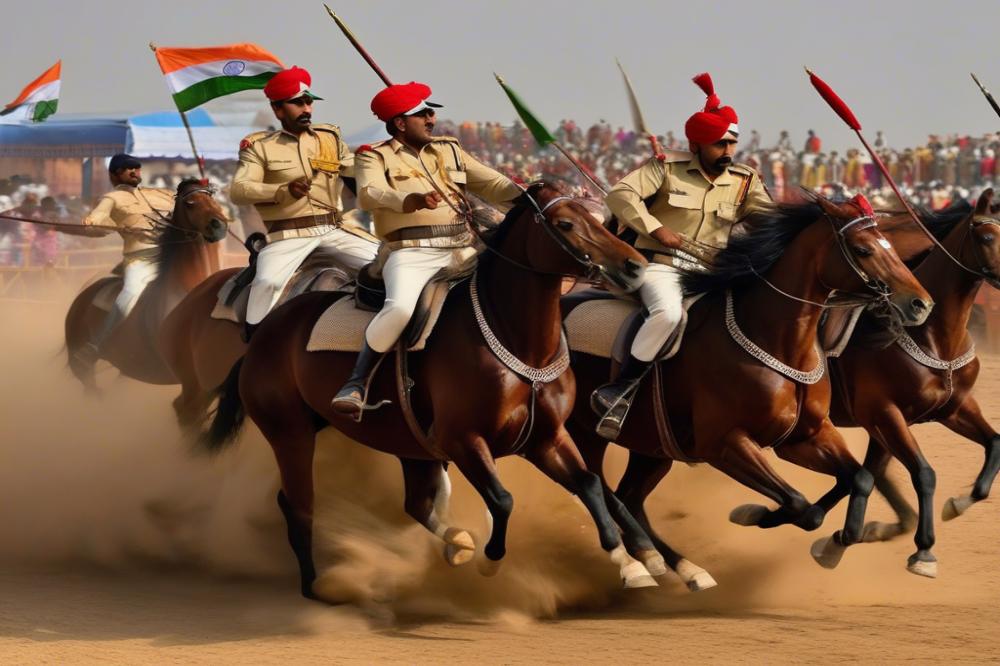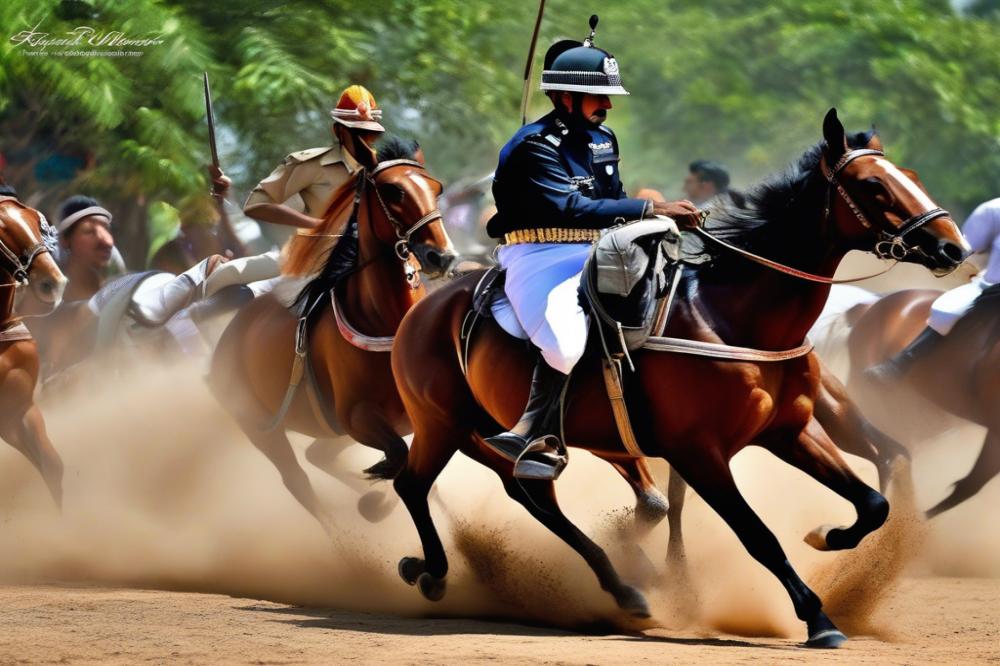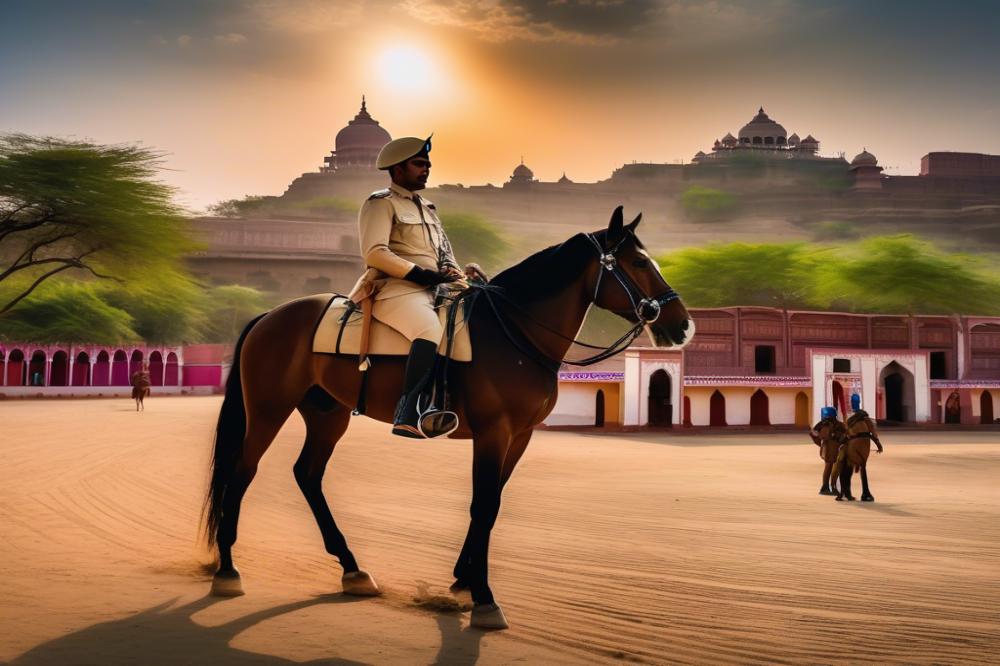Strength and Discipline: The Role of Marwari Horses in India’s Mounted Police Forces
Horses have played a crucial role in law enforcement for centuries. Their presence in police work dates back to ancient times when officers needed reliable partners for patrolling and crowd control. Today, Mounted Police units utilize horses to navigate crowded areas and engage with communities. The bond between officer and horse fosters trust and collaboration, which is vital in maintaining public safety.
Among various horse breeds, Marwari Horses stand out due to their special qualities. Originating from the Marwar region of India, these animals are known for their endurance, agility, and distinctive ears that curve inward at the tips. Such characteristics make them well-suited for demanding environments. Moreover, their intelligence and strong instincts contribute to effective law enforcement tasks.
Strength and discipline are essential attributes in mounted police forces. Officers rely on the physical power of their steeds to manage tense situations. With a robust horse, police can navigate challenges effectively, showing authority and control. Discipline is equally important. Horses need to be trained rigorously to respond promptly to commands, especially in chaotic situations. This training fosters a sense of teamwork between horse and rider, ensuring smooth operations during public events and emergencies.
The Marwari Horse Breed

History and Origin of the Marwari Breed in India
Marwari horses have a rich history that dates back many centuries. They originally come from the Marwar region of Rajasthan. These horses were bred by the local Rajputs for their bravery and Strength. Warriors used them in battles, showcasing their agility and endurance. Over time, this breed became symbolically linked to the culture and pride of Rajasthan. Historical records highlight their loyal service and significant role in transporting troops. Today, the Marwari horse stands as a testament to India’s equestrian heritage. Preserving this legacy has become increasingly important, especially in areas where this breed thrives.
Physical Characteristics that Contribute to Their Suitability for Police Work
Several physical traits make the Marwari breed ideal for service in police forces. They are medium-sized, yet strong, capable of carrying heavy loads. Their characteristic curved ears give them an alert appearance, which enhances their responsiveness. Additionally, these horses possess a strong neck and sturdy legs, allowing them to navigate various terrains easily. Their intelligence is notable; they learn commands quickly and execute them with precision. This adaptability is crucial when facing the unpredictable situations encountered in police work. Police departments rely on horses that can maintain composure under pressure, and Marwaris excel in these conditions.
Cultural Heritage and Significance in Indian Society
Marwari horses hold a place of honor in Indian folklore and tradition. They are often featured in local festivals and ceremonies, symbolizing pride and valor. In many communities, these horses are not just animals but part of the cultural narrative. Families pass down stories about their ancestors riding these magnificent creatures. This breed also finds its place in the royal stables of Rajasthan, representing both heritage and status. Many view the Marwari as a connection to a bygone era, a link to the valorous past. Efforts to promote and protect this breed reflect a broader commitment to maintaining India’s diverse cultural legacy.
Training of Marwari Horses for Law Enforcement

Methods of Training for Mounted Police Duties
Training methods for police tasks involve several techniques. First, horses undergo basic obedience training. Commands are clear and consistent. Exercises often include halting, turning, and moving at various speeds. Riding is also a crucial aspect that focuses on the rider’s control during different situations.
Groundwork is an initial step. This includes leading them, grooming, and desensitizing them to various sounds and movements. Building trust between horse and handler is vital. As they advance, mock situations are introduced. This prepares them for real-life scenarios they may encounter on duty.
Additional training often focuses on agility and response to noise. Police forces require animals that can react calmly in stressful situations. The demand for high adaptability cannot be understated. Horses must learn to manage distractions while maintaining their training.
The Importance of Discipline and Obedience
Discipline plays a key role in a horse’s development for police work. Horses need to respond immediately to commands. This trait helps maintain safety for both the rider and the public. Without obedience, unexpected actions can lead to chaos during critical moments.
Regular practice reinforces learned behaviors. Trust between rider and horse deepens through this routine. Training sessions often emphasize respect and control. Commanding a disciplined horse can mean the difference between order and disorder in law enforcement scenarios.
Comparison with Training Practices for Other Police Horse Breeds
Training practices vary across horse breeds used by police forces. Some breeds may require less time to adapt. Different temperaments influence training styles. While Marwaris are known for their stamina and loyalty, other breeds might excel in speed and agility.
Certain breeds are more sensitive to training methods. They may need gentler approaches. In comparison, some horses might respond well to assertive techniques. The right training approach hinges on understanding each horse’s nature.
Ultimately, the goal remains the same: preparing horses for the duties they must fulfill. The method can change, but the necessity for discipline is a constant. Proper training leads to harmonious relationships between law enforcement and their equine partners.
Role of Marwari Horses in India’s Mounted Police Forces
Overview of Mounted Police Units in India Utilizing Marwari Horses
Mounted police units across India have a long history. Various cities employ these forces to help maintain order. They patrol streets and offer a visible form of authority. The Marwari breed plays a significant role in these units. Known for their agile build and strong presence, these horses can navigate crowded areas.
These police forces often operate in large gatherings or events. They are vital during festivals, parades, and protests. An intuitive nature helps horses respond to the environment. This breed is well-suited for the challenges of city life. Many police units have incorporated them into their training programs.
Specific Duties and Functions Performed by These Horses in Law Enforcement
Law enforcement relies on mounted forces for several essential tasks. These horses help in crowd control situations. A visible police presence deters potential disturbances. They also assist in traffic management during busy times. Officers communicate with pedestrians and drivers while mounted, improving safety.
Furthermore, these animals are useful during search and rescue missions. Officers can cover more ground while riding. Their height provides an advantage in spotting individuals from a distance. Horses have proven effective in finding lost persons in crowded areas or wilderness.
Another important function involves public relations. Officers on horseback interact with community members. This fosters a sense of connection between police and citizens. Engaging with people helps build trust and rapport. Horses serve as approachable symbols of law enforcement.
Case Studies or Examples of Successful Deployments
Numerous instances showcase the effectiveness of mounted police. Many major events see the integration of these horses for crowd control. During significant festivals, their presence enhances safety. Officers are often lauded for their ability to manage large groups smoothly.
In urban spaces, they are instrumental in managing traffic flow. Maneuvering effectively through congested areas is a crucial skill. Nearby businesses and residents appreciate their work. They create a calming presence amidst the hustle and bustle.
Rural areas also benefit from mounted units. In villages, these horses help patrol borders and remote sections. Officers can respond quickly to calls for assistance. The versatility of these animals allows for diverse applications across various environments.
Strength and Discipline: Key Attributes in Policing
Policing requires considerable Strength. Officers must carry out their duties with physical power and stamina. This is especially true when dealing with crowds or chasing suspects. Law enforcement often demands more than just mental capabilities. It often tests an individual’s endurance and ability to act under pressure.
Discipline plays a crucial role in law enforcement. Proper training and adherence to protocols keep everyone safe. Officers must follow strict guidelines to manage unpredictable situations. With discipline, they can effectively coordinate actions during high-stress events. This creates a safe environment for both officers and the public they serve.
Horses like the breed in question are known for their remarkable endurance. They possess a blend of physical strength and mental steadiness. While other horses may excel in speed, this breed stands out for its resilience and reliability. Their natural abilities complement the rigorous demands of police work. This makes them suitable partners in maintaining order.
The combination of strength and discipline can transform policing challenges. A strong horse can easily navigate tough terrains, while disciplined behavior ensures it listens to commands. Officers can rely on such dependable animals during critical operations. Together, they form a powerful team that commands respect and effectively upholds the law.
Challenges and Future of Marwari Horses in Police Forces
Mounted police units across India face several challenges. One of the major issues is the lack of resources. Equipment and maintenance for horses require funding that many departments struggle to allocate. Additionally, training methods can sometimes be outdated. Officers may not receive adequate training on how to manage and care for these animals properly. This can lead to health issues for the horses and reduced effectiveness on duty.
The role of these horses in police work must evolve. With advancements in technology, their utility may change. Drones and vehicles now assist in crowd control and surveillance. However, horses have advantages that machines cannot replicate, such as mobility in crowded spaces and an ability to connect with the public. Maintaining this connection is vital for community policing.
Preservation of the breed is essential for the future. Organizations are working hard to promote breeding programs. These initiatives aim to maintain the distinct characteristics that define the breed. Alongside this, training programs are receiving fresh attention. They focus not only on traditional riding techniques but also on animal welfare and sustainable practices.
Finding new ways to integrate Marwari horses into modern policing is crucial. Collaboration between veterinarians and police trainers may lead to better health outcomes for the animals. This approach can help the units operate more effectively while ensuring the horses remain a symbol of strength and discipline. Regular workshops and seminars are becoming more common, which promotes knowledge sharing among officers.
Community involvement can also play a significant role. Awareness programs help educate the public about the importance of these horses in the police force. When people understand their value, support for maintaining these units may increase. Building a stronger bond with the community can lead to better outcomes in policing efforts. Overall, the future looks promising if challenges are met with innovation and cooperation.
Final Reflections on Heritage and Law Enforcement
Marwari horses play a vital role in India’s mounted police forces. These animals are not just practical tools; they symbolize resilience and pride. Law enforcement uses them for crowd control and ceremonial duties. Yet, their value extends far beyond these functions.
Tradition is deeply woven into the fabric of these majestic creatures. They represent the rich heritage of the Indian culture and the enduring spirit of the people. Riders and horses form a partnership that is both functional and emblematic. Together, they embody the values of strength and discipline that are essential in policing.
Maintaining customs in modern law enforcement is important. As society evolves, it can be easy to lose touch with traditions. However, integrating time-honored practices can enrich today’s approach to policing. The mounted units serve as reminders of our past while effectively addressing contemporary challenges.
Respecting this connection can instill a sense of pride in communities. People see these horses and immediately recognize their significance. They are a true representation of our history and values. For the officers, the bond with their steed is more than just practical; it signifies trust and companionship.
In conclusion, the Marwari horses have much to offer. They remind us of the past even as they serve in the present. By honoring these traditions, law enforcement can foster a deeper connection with the community it serves.



